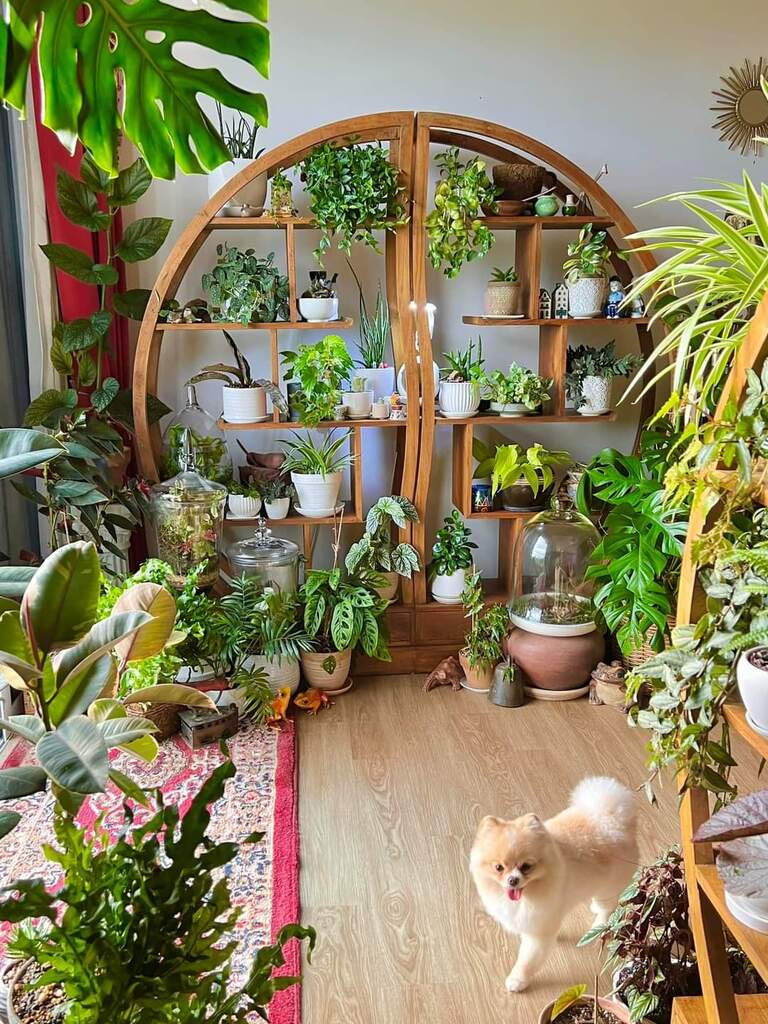Several types of plants thrive in indoor wall gardens due to their adaptability to low light conditions and ability to grow vertically. Here are some popular options:
1. Pothos (Epipremnum aureum): Pothos is a low-maintenance vine that can tolerate low light conditions and is known for its trailing growth, making it ideal for hanging or cascading from a wall garden.
2. Spider Plant (Chlorophytum comosum): Spider plants are resilient and easy to grow indoors. They produce long, arching foliage that can add a graceful touch to a vertical garden.
3. Snake Plant (Sansevieria trifasciata): Snake plants are known for their striking upright leaves and ability to tolerate low light and neglect. They make an excellent choice for vertical gardens, adding structure and visual interest.
4. Ferns: Various types of ferns, such as Boston ferns or maidenhair ferns, thrive in low light and high humidity conditions. They add a lush and elegant look to indoor wall gardens.
5. Philodendron: Philodendrons are versatile plants that come in various shapes and sizes, including trailing and climbing varieties. They are well-suited for indoor wall gardens due to their tolerance of low light and adaptable growth habits.
6. Succulents: Certain succulent species, like Haworthia, Sedum, or Echeveria, can thrive in indoor wall gardens, especially if they receive some direct sunlight. They add texture and variety to vertical arrangements.
7. Air Plants (Tillandsia): Air plants are epiphytes that don’t require soil to grow. They can be mounted onto vertical surfaces using adhesive or placed in pockets or holders within a wall garden, adding a unique and contemporary touch.
8. Peace Lily (Spathiphyllum): Peace lilies are known for their elegant white flowers and glossy green leaves. They can tolerate low light conditions and help purify the air, making them suitable for indoor vertical gardens.
9. English Ivy (Hedera helix): English ivy is a vigorous climber that can be trained to grow vertically along a wall or trellis. It thrives in low to moderate light and adds a classic, timeless look to indoor spaces.
10. ZZ Plant (Zamioculcas zamiifolia): ZZ plants are known for their glossy, dark green foliage and resilience to low light and drought. They make a great addition to indoor wall gardens, adding a touch of modernity and sophistication.
When selecting plants for your indoor wall garden, consider factors such as the available light, humidity levels, and the overall design aesthetic you want to achieve.
Creating an indoor wall garden involves several steps:
1. Choose the Right Location: Select a spot with good natural light for your indoor wall garden. South or west-facing windows are usually ideal, but you can also use artificial grow lights if needed.
2. Select the Plants: Choose plants that thrive indoors and are suitable for vertical gardening. Consider factors like light requirements, humidity levels, and the available space. Some popular options include pothos, ferns, succulents, and air plants.
3. Choose a Vertical Garden System: Decide on the type of vertical garden system you want to use. Options include wall-mounted planters, modular vertical garden kits, or DIY vertical garden structures made from pallets or shelves.
4. Prepare the Wall: Ensure the wall is clean and free from debris. If you’re using a modular system, follow the manufacturer’s instructions for installation. If you’re DIY-ing it, securely attach shelves or planters to the wall.
5. Planting: Plant your chosen plants in the vertical garden containers using well-draining potting soil. Be mindful of spacing and consider the mature size of the plants.
6. Watering and Maintenance: Establish a watering routine based on the needs of your plants. Some may require more frequent watering than others. Monitor the moisture levels regularly and adjust your watering schedule accordingly. Additionally, regularly prune and remove dead or yellowing leaves to keep the garden healthy.
7. Lighting: If natural light is insufficient, supplement with artificial grow lights placed near the wall garden to ensure the plants receive adequate light for growth.
8. Fertilizing: Indoor plants may benefit from occasional fertilization. Use a balanced indoor plant fertilizer according to the instructions on the packaging.
9. Monitor and Adjust: Keep an eye on your wall garden and make adjustments as needed. This could include rotating plants for even growth, repotting if they outgrow their containers, or adjusting watering and lighting based on seasonal changes.
By following these steps, you can create a beautiful and thriving indoor wall garden to enjoy year-round.
Creating an indoor wall garden offers numerous advantages:
1. Space Efficiency: Utilizes vertical space, making it ideal for small living areas or apartments with limited floor space.
2. Enhanced Aesthetics: Adds a visually appealing green element to indoor spaces, improving the overall ambiance and aesthetics.
3. Air Purification: Indoor plants naturally purify the air by removing toxins and pollutants, promoting cleaner indoor air quality.
4. Stress Reduction: Studies have shown that being around plants can reduce stress levels and promote feelings of well-being and relaxation.
5. Temperature Regulation: Plants help regulate indoor temperatures by releasing moisture into the air through a process called transpiration, contributing to a more comfortable living environment.
6. Sound Absorption: Plants can absorb and dampen sound, reducing noise levels within indoor spaces and creating a quieter atmosphere.
7. Biophilic Benefits: Enhances biophilic design principles by bringing nature indoors, which has been linked to increased productivity, creativity, and overall happiness.
8. Food Production: Some wall gardens can be used to grow herbs, vegetables, or fruits indoors, providing a fresh and convenient source of homegrown produce.
9. Customization: Indoor wall gardens offer flexibility in plant selection and arrangement, allowing individuals to personalize their space according to their preferences and style.
10. Educational Opportunities: Provides a hands-on learning experience for both adults and children, fostering a deeper appreciation for nature and the environment while learning about plant care and cultivation techniques.

